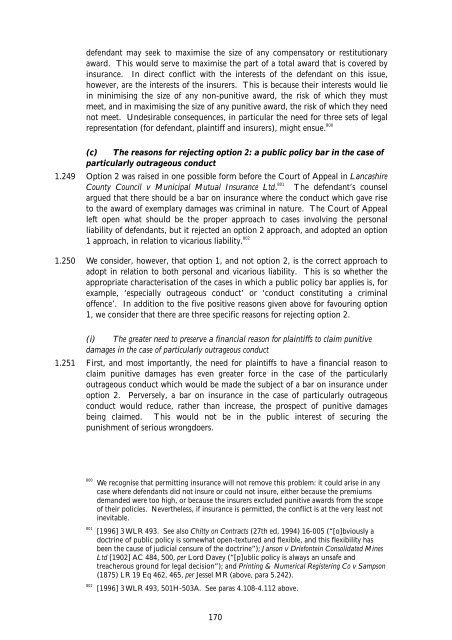Aggravated, Exemplary and Restitutionary ... - Law Commission
Aggravated, Exemplary and Restitutionary ... - Law Commission
Aggravated, Exemplary and Restitutionary ... - Law Commission
You also want an ePaper? Increase the reach of your titles
YUMPU automatically turns print PDFs into web optimized ePapers that Google loves.
defendant may seek to maximise the size of any compensatory or restitutionary<br />
award. This would serve to maximise the part of a total award that is covered by<br />
insurance. In direct conflict with the interests of the defendant on this issue,<br />
however, are the interests of the insurers. This is because their interests would lie<br />
in minimising the size of any non-punitive award, the risk of which they must<br />
meet, <strong>and</strong> in maximising the size of any punitive award, the risk of which they need<br />
not meet. Undesirable consequences, in particular the need for three sets of legal<br />
representation (for defendant, plaintiff <strong>and</strong> insurers), might ensue. 800<br />
(c) The reasons for rejecting option 2: a public policy bar in the case of<br />
particularly outrageous conduct<br />
1.249 Option 2 was raised in one possible form before the Court of Appeal in Lancashire<br />
County Council v Municipal Mutual Insurance Ltd. 801<br />
The defendant’s counsel<br />
argued that there should be a bar on insurance where the conduct which gave rise<br />
to the award of exemplary damages was criminal in nature. The Court of Appeal<br />
left open what should be the proper approach to cases involving the personal<br />
liability of defendants, but it rejected an option 2 approach, <strong>and</strong> adopted an option<br />
1 approach, in relation to vicarious liability. 802<br />
1.250 We consider, however, that option 1, <strong>and</strong> not option 2, is the correct approach to<br />
adopt in relation to both personal <strong>and</strong> vicarious liability. This is so whether the<br />
appropriate characterisation of the cases in which a public policy bar applies is, for<br />
example, ‘especially outrageous conduct’ or ‘conduct constituting a criminal<br />
offence’. In addition to the five positive reasons given above for favouring option<br />
1, we consider that there are three specific reasons for rejecting option 2.<br />
(i) The greater need to preserve a financial reason for plaintiffs to claim punitive<br />
damages in the case of particularly outrageous conduct<br />
1.251 First, <strong>and</strong> most importantly, the need for plaintiffs to have a financial reason to<br />
claim punitive damages has even greater force in the case of the particularly<br />
outrageous conduct which would be made the subject of a bar on insurance under<br />
option 2. Perversely, a bar on insurance in the case of particularly outrageous<br />
conduct would reduce, rather than increase, the prospect of punitive damages<br />
being claimed. This would not be in the public interest of securing the<br />
punishment of serious wrongdoers.<br />
800 We recognise that permitting insurance will not remove this problem: it could arise in any<br />
case where defendants did not insure or could not insure, either because the premiums<br />
dem<strong>and</strong>ed were too high, or because the insurers excluded punitive awards from the scope<br />
of their policies. Nevertheless, if insurance is permitted, the conflict is at the very least not<br />
inevitable.<br />
801 [1996] 3 WLR 493. See also Chitty on Contracts (27th ed, 1994) 16-005 (“[o]bviously a<br />
doctrine of public policy is somewhat open-textured <strong>and</strong> flexible, <strong>and</strong> this flexibility has<br />
been the cause of judicial censure of the doctrine”); Janson v Driefontein Consolidated Mines<br />
Ltd [1902] AC 484, 500, per Lord Davey (“[p]ublic policy is always an unsafe <strong>and</strong><br />
treacherous ground for legal decision”); <strong>and</strong> Printing & Numerical Registering Co v Sampson<br />
(1875) LR 19 Eq 462, 465, per Jessel MR (above, para 5.242).<br />
802 [1996] 3 WLR 493, 501H-503A. See paras 4.108-4.112 above.<br />
170
















